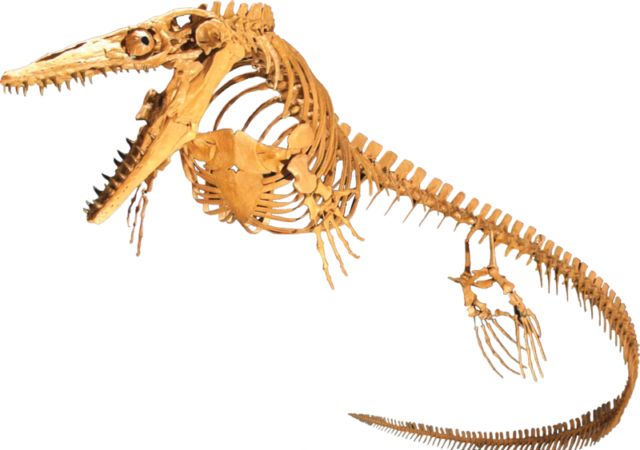Researchers from the University of Cincinnati have revealed that the 72 million-year-old fossil of a mosasaur has been unearthed in the town of Mukawa, Japan.
The unique fossil, embedded in rock, was first observed in 2009. What makes this discovery unusual is the location of the reptile’s large eyes as well as its body length of only 10 feet. Previously discovered species of mosasaurs, an extinct group of reptiles living in water, have typically been up to 40 to 60 feet in length, about the size of a Tyrannosaurus Rex.

Paleontologists at the Hobetsu Museum in Hokkaido used an overnight acid wash with a daily rinse for two years to reveal the creature’s fossilized head and remove the bones from the rock. At that time, casts were fashioned to allow researchers to reconstruct the skull without damaging the original bones. “It’s so unusually well-preserved that, upon separating jumbled skull bones from one another, we were able to build a perfect skull with the exception of the anterior third of the snout,” says Dr. Takuya Konishi, a paleontologist at the University of Cincinnati. Researchers from the University have given the creature the name Phosphorosaurus Ponpetelegans, which means “phosphorus lizard from an elegant creek”.
According to Dr. Konishi, “the forward facing eyes on Phosphorosaurus Ponpetelegans provided depth perception to vision, common in birds of prey and other predatory mammals that dwell among us today, but we knew already that most mosasaurs were pursuit predators based on what we know of swimming animals.”

The well-preserved fossil, found in a small river in Northern Japan, is believed to have been a marine reptile from the late Cretaceous period just before the emergence of more familiar dinosaurs such as the Tyrannosaurus and Triceratops. Unlike other mosasaurs of the time, the Phosphorosaurus Ponpetelegans had underdeveloped fins and tail which limited the animal’s swimming ability in areas of deep water. In a paper published in the Journal of Systematic Paleontology, researchers stated that due to the fact of the front-facing large eyes allowing more light into the photoreceptors, this new species would have been a nocturnal hunter, sitting in the dark water of the deep waiting for prey. It could detect bioluminescent light given off by fish and squid-like animals also found in areas of Japan hosting rivers with deep water. This practice allowed the smaller Phosphorosaurus Ponpetelegans to live in harmony with larger, fast swimming mosasaurs. “If this new mosasaur was a sit-and-wait hunter in the darkness of the sea and able to detect the light of these other animals, that would have been the perfect niche to coexist with the more established mosasaurs,“ said Dr. Konishi.

The remains of the Phosphorosaurus Ponpetelegans are the first marine reptiles to be found in Japan. The area between the Middle East and the eastern Pacific had previously been believed to be devoid of any marine reptiles. “Previous discoveries of this particular rare mosasaur have occurred along the East Coast of North America, the Pacific Coast of North America, Europe, and North Africa, but this is the first to fill the gap between the Middle East and the Eastern Pacific,” states research team member Dr. Konishi.
Dr. Konishi and his team – Michael W. Caldwell, Department of Biological Sciences and Earth and Atmospheric Sciences, University of Alberta; Tomohiro Nishimura and Kazuhiko Sakurai, Hobetsu Museum; and Kyo Tanoue, Fukuoka University – are looking forward to future research in order to examine how this new species will change existing knowledge of the prehistoric oceans.
